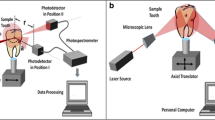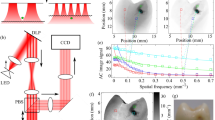Abstract
Introduction
The aim of this study was to experimentally investigate the potential of different light wavelengths to distinguish between healthy and carious tissue using a two-circle goniometer.
Materials and methods
Tooth slices were prepared from extracted human teeth that were caries free (n = 15) or had occlusal caries lesions (n = 10). The tooth slices were irradiated with diode laser modules of different wavelengths (532, 650, 780 nm). The transmitted and scattered laser light was spatially measured with a detector rotating on a two-circle goniometer. The anisotropy factor and attenuation coefficients were calculated.
Results
Enamel was more transparent than dentin and showed wavelength-dependent attenuation. Healthy dentin showed strong light scattering at all wavelengths, independent of the tested wavelength. The calculated attenuation coefficients of carious and healthy tooth tissue differed significantly (p < 0.05; t test). In contrast to healthy enamel, carious enamel showed lower light transmission and an increase in scattering. Differences in the light attenuation of carious versus healthy dentin were less pronounced than those for enamel. Carious dentin was slightly more transparent than healthy dentin. The light of longer wavelengths showed a better penetration of all tooth structures compared with shorter wavelengths.
Conclusion
Healthy and carious dentin and enamel exhibited distinct optical properties using laser light at different wavelengths. In dentin, changes in the optical properties caused by caries are significantly less pronounced.
Clinical relevance
The clear distinction between healthy and carious enamel makes optical caries diagnostic systems ideal tools for early caries detection.




Similar content being viewed by others
References
Buehler CM, Ngaotheppitak P, Fried D (2005) Imaging of occlusal dental caries (decay) with near-IR light at 1310-nm. Opt Express 2:573–582. https://doi.org/10.1364/OPEX.13.000573
Karlsson L (2010) Caries detection methods based on changes in optical properties between healthy and carious tissue. Int J Dent 2010:1–9. https://doi.org/10.1155/2010/270729
Fried D, Staninec M, Darling CL, Staninec M, Lee C et al (2010) Near-infrared imaging of dental decay at 1310 nm. J Laser Dent 18:8–16
Spitzer D, Bosch JT, ten Bosch JJ (1975) The absorption and scattering of light in bovine and human dental enamel. Calcif Tissue Res 2:129–137. https://doi.org/10.1007/BF02547285
Ten Bosch JJ, Zijp JR (1987) Optical properties of dentin. Dentine Reactions in the Oral Cavity 34–40
Fried D, Glena RE, Featherstone JD et al (1995) Nature of light scattering in dental enamel and dentin at visible and near-infrared wavelengths. Appl Opt 7:1278–1285. https://doi.org/10.1364/AO.34.001278
Jones RS, Fried D (2002) Attenuation of 1310- and 1550-nm laser light through sound dental enamel. Int Soc Opt Eng 4610:187–190. https://doi.org/10.1117/12.469324
Jones RS, Huynh GD, Jones GC, Fried D (2003) Near-infrared transillumination at 1310-nm for the imaging of early dental decay. Opt Express 11:2259–2265. https://doi.org/10.1364/OE.11.002259
Darling CL, Huynh GD, Fried D (2006) Light scattering properties of natural and artificially demineralized dental enamel at 1310 nm. J Biomed Opt 11:1–11. https://doi.org/10.1117/1.2204603
Chan AC, Darling CL, Chan KH et al (2014) Attenuation of near-IR light through dentin at wavelengths from 1300-1650-nm. Proc SPIE Int Soc Opt Eng 8929:1–5. https://doi.org/10.1117/12.2045629
Pretty IA (2006) Caries detection and diagnosis: novel technologies. J Dent 10:727–739. https://doi.org/10.1016/j.jdent.2006.06.001
Fried D, Featherstone JDB, Darling CL, Jones RS, Ngaotheppitak P, Bühler CM (2005) Early caries imaging and monitoring with near-infrared light. Dent Clin N Am 4:771–793. https://doi.org/10.1016/j.cden.2005.05.008
Kühnisch J, Ifland S, Tranaeus S et al (2006) Establishing quantitative light-induced fluorescence cut-offs for the detection of occlusal dentine lesions. Eur J Oral Sci 6:483–488
Amaechi BT (2009) Emerging technologies for diagnosis of dental caries: the road so far. J Appl Phys 10:1–9. https://doi.org/10.1063/1.3116632
Kühnisch J, Söchtig F, Pitchika V, Laubender R, Neuhaus KW, Lussi A, Hickel R (2016) In vivo validation of near-infrared light transillumination for interproximal dentin caries detection. Clin Oral Investig 4:821–829. https://doi.org/10.1007/s00784-015-1559-4
Lederer A, Kunzelmann K-H, Heck K, Hickel R, Litzenburger F (2019) In vitro validation of near-infrared transillumination at 780 nm for the detection of caries on proximal surfaces. Clin Oral Investig 23:1–8. https://doi.org/10.1007/s00784-019-02824-0
Lederer A, Kunzelmann KH, Hickel R, Litzenburger F (2018) Transillumination and HDR imaging for proximal caries detection. J Dent Res 7:844–849. https://doi.org/10.1177/0022034518759957
Bader JD, Shugars DA (2004) A systematic review of the performance of a laser fluorescence device for detecting caries. J Am Dent Assoc 10:1413–1426. https://doi.org/10.14219/jada.archive.2004.0051
Roither Laser Technik GmbH (2020) Technical Data, Rothdiener Laser. http://www.roithner-laser.com/datasheets/laser/laser_modules/apcd-650-02-c2.pdf 29.05.2020 Accessed 08:45
Bohren CF, Huffman DR (eds) (2007) Absorption and scattering of light by small particles. Wiley-VCH, Weinheim
Zijp JR, ten Bosch JJ (1991) Angular dependence of HeNe-laser light scattering by bovine and human dentine. Arch Oral Biol 4:283–289. https://doi.org/10.1016/0003-9969(91)90098-F
Zijp JR, ten Bosch JJ, Groenhuis RA (1995) HeNe-laser light scattering by human dental enamel. J Dent Res 12:1891–1898. https://doi.org/10.1177/00220345950740121301
Sardar DK, Mayo ML, Glickman RD (2001) Optical characterization of melanin. J Biomed Opt 4:404–411. https://doi.org/10.1117/1.1411978
Bohren CF, Huffman DR (eds) (2008) Absorption and scattering of light by small particles. Wiley-VCH, Weinheim
Popp J, Tučin VV, Chiou A et al (eds) (2011) Basics and techniques. Wiley-VCH, Weinheim
Marshall GW, Chang YJ, Gansky SA et al (2001) Demineralization of caries-affected transparent dentin by citric acid: An atomic force microscopy study. Dent Mater 1:45–52. https://doi.org/10.1016/S0109-5641(00)00056-7
Manly R, BROOKS E (1947) Transparency and light scattering of dental hard tissues. J Dent Res 6:427–434. https://doi.org/10.1177/00220345470260060601
Tranaeus S, Shi X-Q, Angmar-Månsson B (2005) Caries risk assessment: methods available to clinicians for caries detection. Community Dent Oral Epidemiol 4:265–273. https://doi.org/10.1111/j.1600-0528.2005.00234.x
Shi XQ, Tranaeus S, Angmar-Månsson B (2001) Comparison of QLF and DIAGNOdent for quantification of smooth surface caries. Caries Res 1:21–26. https://doi.org/10.1159/000047426
Marinova-Takorova M, Anastasova R, Panov VE (2014) Comparative evaluation of the effectiveness of five methods for early caries diagnosis of occlusal caries lesions – in vitro study. JofIMAB 3:533–536. https://doi.org/10.5272/jimab.2014203.533
Lederer A, Kunzelmann K-H, Heck K, Hickel R, Litzenburger F (2019) In-vitro validation of near-infrared reflection for proximal caries detection. Eur J Oral Sci 6:515–522. https://doi.org/10.1111/eos.12663
Author information
Authors and Affiliations
Contributions
These authors contributed equally to this paper.
Corresponding author
Ethics declarations
Conflict of interest
The authors declare that they have no conflict of interest.
Ethical approval
This article does not contain any studies with human participants or animals performed by any of the authors. All experimental procedures were approved by the Ethics Committee of the Faculty of Medicine of the Ludwig Maximilians University in Munich, Germany (488-15 UE).
Informed consent
For this type of study, formal consent is not required.
Additional information
Publisher’s note
Springer Nature remains neutral with regard to jurisdictional claims in published maps and institutional affiliations.
Rights and permissions
About this article
Cite this article
Hoffmann, L., Feraric, M., Hoster, E. et al. Investigations of the optical properties of enamel and dentin for early caries detection. Clin Oral Invest 25, 1281–1289 (2021). https://doi.org/10.1007/s00784-020-03434-x
Received:
Accepted:
Published:
Issue Date:
DOI: https://doi.org/10.1007/s00784-020-03434-x




